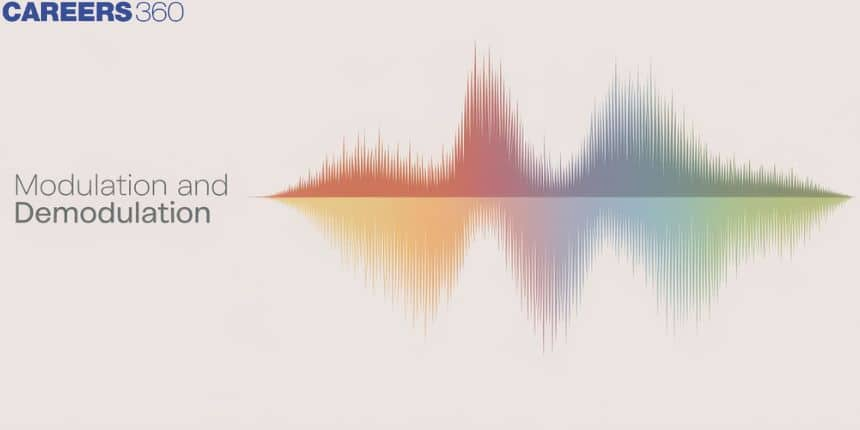Modulation and Demodulation - Definition, Advantages, Types, FAQs
Modulation and demodulation play an important part in the communication systems where they help in transmitting and receiving signals to cover long distances. Modulation is changing a carrier signal to represent information in it, while demodulation derives original information carried by modulated signals. These two functions are widely used in applications such as radio, television, and, now increasingly, digital communications for clearer and more reliable data transfer.
JEE Main/NEET 2027: Physics Important Formulas for Class 10
NEET 2025: Mock Test Series | Syllabus | High Scoring Topics | PYQs
JEE Main: Study Materials | High Scoring Topics | Preparation Guide
JEE Main: Syllabus | Sample Papers | Mock Tests | PYQs
- What is Modulation?
- Define Demodulation
- Difference Between Modulation and Demodulation

What is Modulation?
It is the method of converting some given data into radio waves by adding certain information to a carrier signal and it does not affect the original properties and even the characteristics of the transmitted message signal. If the characteristics of the message signal get changed, then the message contained in it also gets changed or even altered. Hence, it is essential to take precautions regarding transmitted message signals.
A high-frequency signal may travel up to a larger distance and the chances of getting affected by external disturbances are less.
We often take help from such a high-frequency signal, also called allowed →Improving as a carrier signal for transmitting the message signal. This explained process is known as Modulation.
There are three types of modulation, namely:
Frequency Modulation
Amplitude Modulation
Phase Modulation
1. Amplitude Modulation
It is a kind of modulation where the amplitude of the carrier signal is changed in proportion to the message signal while the phase and frequency are kept constant.
2. Phase Modulation
If the phase of the given carrier wave gets changed by the instantaneous value of the modulating signal, then it is called Phase Modulation.
3. Frequency Modulation
If the frequency of the given carrier wave gets changed, by the instantaneous value of the modulating signal, then it is called a Frequency Modulation.
Also, read
- NCERT Solutions for All Subjects
- NCERT Notes For All Subjects
- NCERT Exemplar Solutions for All Subjects
Advantages of Modulation
The advantages of modulation are as follows:
1. The size of the antenna decreases
2. There is no space for signal mixing
3. Bandwidth adjustments are allowed
4. Improving the quality of reception
Disadvantages of Modulation
Despite its advantages, modulation has some downsides:
Complexity: Certain types of modulation (like FM and PM) are more complex and expensive to implement.
Bandwidth Requirements: Techniques like FM require a larger bandwidth, which may limit the number of channels available for communication.
Power Consumption: Some modulation techniques require more power to transmit signals, particularly for long-range communication.
Define Demodulation
Demodulation is generally described as displacing that original information-carrying signal from the original modulated carrier wave. A demodulator is an electronic circuit used mainly for information retrieval from the modulated carrier wave. There are various modulations and thus different kinds of demodulators. The output signal of an outgoing demodulator may represent sound, images, or binary data.
Advantages of Demodulation
Restores Original Signal: retrieves the original information sent by the transmitter, ensuring that the intended message is received accurately.
Noise Filtering: Certain demodulation techniques help filter out noise and interference, improving signal clarity.
Enables Digital Communication: Demodulation is crucial for digital systems, as it converts modulated signals back into binary data.
Disadvantages of Demodulation
Complex Circuits: Some demodulation techniques require complex circuitry, making implementation challenging in certain applications.
Signal Loss: During the demodulation process, some signal degradation may occur, especially in poor communication channels.
Difference Between Modulation and Demodulation
| Feature | Modulation | Demodulation |
| Definition | The process of encoding information onto a carrier wave. |
The process of extracting the original information from the carrier wave. |
| Purpose | Facilitates transmission over long distances. |
Retrieves the transmitted information at the receiver's end. |
| Types | AM, FM, PM, PCM, BPSK, FSK, PWM. |
AM demodulation, FM demodulation, phase demodulation. |
| Circuit Complexity | Varies from simple (AM) to complex (FM, PSK). |
Demodulation circuits are often simpler than modulation circuits. |
| Role in Communication | Occurs at the transmission stage. |
Occurs at the reception stage. |
Frequently Asked Questions (FAQs)
- Amplitude Modulation
- Frequency Modulation
- Phase Modulation
- The size of their antenna decreases
- There is no space for signal mixing.
- bandwidth adjustments are allowed
- Improving the quality of reception
An envelope is defined as a line of thought that combines the positive and the negative points of a carrier wave.
It is a wave usually mounted on a carrier wave with a high frequency.
It is used for recovering original information content from a modulated carrier wave.
Also Read
27 Nov'24 12:23 AM
25 Sep'24 06:35 PM
25 Sep'24 06:34 PM
25 Sep'24 12:40 PM

